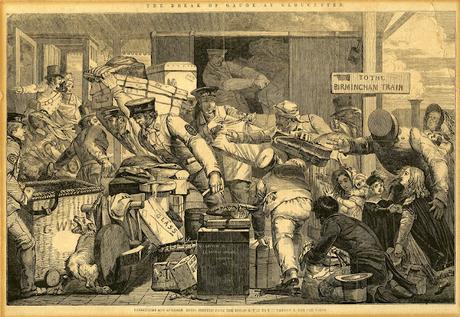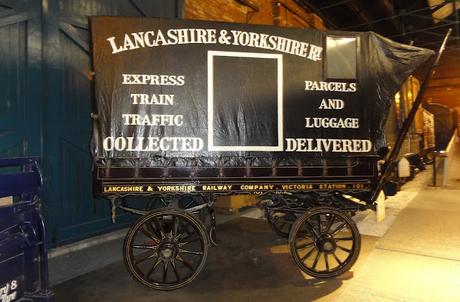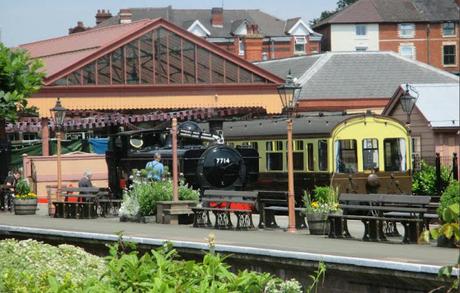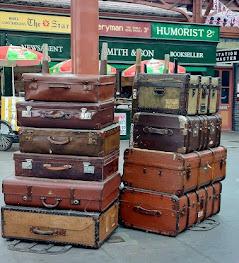But I do have a soft spot for that golden age of travel between, let’s say, the 1860s and 1930s when railway station platforms and the sides of liners in dock would be awash with luggage of all shapes and sizes. When I started to think about the subject I began to wonder how on earth the suitcases, bags and cases actually got sorted out.

At the beginning of the railway era, moving passengers and their luggage trunks was little more than a lottery. Luggage not stored in basically more than a rudimentary goods wagon was lifted onto carriage roofs, strapped down and protected by tarpaulin. Any trunks not securely fastened might tumble off and be lost in transit.By the 1870s, the use of railway guards vans—containing floor space for trunks and parcels, and a fold down seat and desk for the guard—was far more prevalent.
In time there was further expansion of specialist vehicles that came about according to former National Railway Museum carriage curator David Jenkinson, as ‘the natural outcome of the sheer volume of luggage which, increasingly, during late Victorian and Edwardian days, the ever-growing numbers of passengers wished to take with them on their journeys.’Railway companies became adept managers of the passenger luggage process, allowing travellers to forward-plan individual requirements. At stations carefully labelled luggage could be left in advance of travel. This then could be put on a train ahead of departure or alternatively placed on the train on the day of travel by guards who ensured personal possessions arrived safely at the destination with the traveler. Passengers simply collected their luggage at journey’s end or arranged to have it delivered to where they were staying by the railway company.

Travel and holiday planning were part of a new-wave industry attracting the attentions of specialist organisations. Firms such as Pickfords Travel included a separate connected business for the cartage of passengers’ advanced luggage to Victoria and other main London stations. This was a new outlet for which the company received a business commission.Into this mix could be added left luggage and baggage storage for which railway stations were ideal. For couples or family groups, the opportunity of being able to leave luggage in secure and staffed facilities safely for just a few hours or for longer periods was a tremendous traveler enhancement, especially for passengers waiting for a train at a main station terminus that could be several hours later. For passengers with a minimal amount of luggage such as an attaché, brief case or small suitcase, convenient self-service locker facilities emerged at mainline railway stations.As a result, the management of passenger luggage became a key part of the railway company’s remit. Railway porters strolling along station platforms with their trucks were familiar sights. For passengers not wishing to leave their luggage to the safety of the railway company, carriage compartments with special overhead racks provided perfect sanctuary.By the 1930s traveling in style became de-rigueur, refined luggage was a status symbol, part of a sense of individual style, and just as important as personal appearance. Not perhaps the first consideration of the many thousands heading to places like Blackpool in the season.But mention of carriage compartments and luggage (and, of course, style) always reminds me that you can still get a tiny sense of that 1930s travel by going to the Severn Valley Railway. How I love that Kidderminster station.

Severn Valley Railway with Geraldine
Kidderminster to Bewdley: 1120 hrs
I could have stayed all day
surrounded by suitcases and the 30s
but we had a train to catch
and oh my word did we get one
seven carriages in brown and cream
we got a compartment
slid the door shut
put on do not disturb faces
until we were safely in Worcestershire
where elephants roamed
as you said they would
Bewdley to Arley: 1134 hrs
We’d calmed down by now
time to stroll the corridor
nodding to other travelers
I do wish I’d had a hat
you went for your camera
but didn’t come back
which I thought was odd
but nowhere near as odd
as finding you gesticulating
A Strap A Strap
this window has a strap.
Arley to Highley: 1150 hrs
We settled into the rhythms
of our Midland adolescence
you seemed to stay by the river
while I let patches of thought
hitch onto clouds of white smoke
drifting into woods
on the other side of the valley.
Highley to Hampton Loade: 1201 hrs
We got back on track
( I’m allowed to say that )
and began to notice
wooden cabins with verandah views
of us on a steam train
at the end of well tended gardens
we waved at people on the river path
they waved back
I wondered if the VR in SVR
had more than one meaning
nothing is this perfect
Hampton Loade to Bridgenorth: 1213 hrs
The Guard slid open the door
to clip our cardboard tickets
and how I wanted to be him
while you could be one of the porters
waistcoat and sleeves rolled up
chatting to passengers
in the snug waiting rooms
or guiding folk off the train
that you in your peaked cap
wave off with whistle and flag
and I was just about to rant
that this is how it should be
instead of desolate toiletless
perspex-ridden staff sacked platforms
when we arrived spot on 1228
the end of the line
but not if you include tea
and scones at the station café.

First published in The Journal, Oct 21Thanks for reading, Terry Q. Email ThisBlogThis!Share to TwitterShare to Facebook
